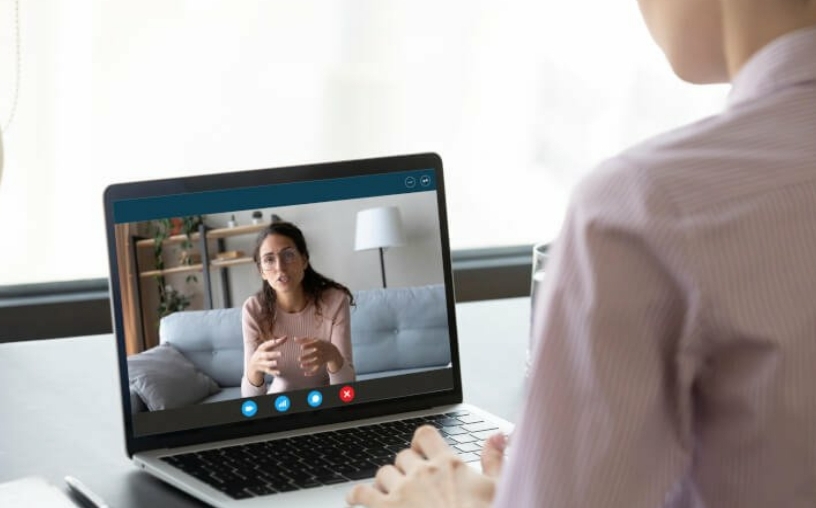
COVID-19 dramatically impacted psychology practice. What does the future of telepsychology hold?
With telehealth usage rates skyrocketing, experts say resolving concerns around privacy and security, access to care, and payments for providers will be critical as many psychologists adjust to providing care remotely during the ongoing COVID-19 pandemic.
Resolving those concerns will be critical to making sure psychologists can continue offering telehealth as demand for mental health services grows, particularly services offered virtually.
Several studies have already proven telepsychology’s effectiveness. And research from Jeanine Turner, PhD, a professor of communication, culture, and technology at Georgetown University who has followed telehealth’s growth over the past two decades, has shown that both patients and providers who use telehealth generally view it favorably.
While the technology and infrastructure for telehealth has been available since the mid-1990s, Turner says the health care industry never would have embraced telehealth fully without a status quo–ending event like a pandemic.
“Last year, within weeks, the system had to absorb all the challenges of wide-scale adoption,” says Turner. “Now, it’s taken off—and there will be no going back.”
The COVID-19 pandemic has basically forced most health care providers to see patients remotely, but psychologists have unique concerns and questions about the virtual delivery of their services. For instance, how might technology impact the therapeutic alliance? And mental health care, by definition, has a strong emotional dimension. Can that really be honored online?
It appears that it can, according to Ashley Batastini, PhD, an assistant professor in the Department of Counseling, Educational Psychology and Research at the University of Memphis.
Batastini and her colleagues recently published a large meta-analytic study that compared clinical interventions and assessments delivered via videoconferencing with those delivered in-person. Overall, they found that in-person and virtual interventions produced similar outcomes. Likewise, assessments produced similar opinions across modalities, she says.
“It was important for us to compare virtual delivery to in-person delivery, and not to baseline,” Batastini says. “We wanted to see how much physical presence in the same room mattered.”
The result was not a surprise to Batastini and her team. She says their conclusions were in line with the existing literature on telepsychology, including a 2016 meta-analysis by the same team that focused on correctional and forensic telepsychology. (Batastini and her colleagues did uncover one interesting surprise in the new study: Women appear to have better outcomes following virtual interventions than in-person interventions, something that merits further research, she says.)
Batastini hopes that this study will help assuage lingering concerns that psychologists may have about the impact of virtual delivery on their services. “I think telepsychology is here to stay, and it’s important for us to adapt, not resist,” she says.
Batastini does have a word of caution for those “hailing telepsychology as the key to improving access to care.” While her team’s study had a compelling conclusion, it also revealed some significant limitations in the existing literature on tele-psychology—namely, inconsistent quality across studies.
“What we know is certainly promising, but we need more scientifically rigorous studies and a better understanding of what works and for whom,” she says.
She emphasizes the importance of improving all patients’ access to the internet and to private spaces, which are both crucial for the success of virtual interventions or assessments.
“For vulnerable or underserved clients, this task may prove more difficult. One possibility psychologists might consider is establishing partnerships with local community organizations or other spaces that offer private, centralized, and clean spaces for clients to attend sessions, such as libraries, medical centers, community colleges, or courthouses,” Batastini says.
But concerns about the privacy and security of tele-psychology are not limited to the patient’s side of the screen. Psychologists need to be aware of the general privacy and security risks, such as the possibility of data breaches, and take steps to minimize them. According to Batastini, there are two components to managing these risks.
First, psychologists must do their own research and make certain that the platforms they’re using are complaining with the Health Insurance Portability and Accountability Act (HIPSS), particularly with HIPAA’s Security Rule and Privacy Rule.
There are a variety of platforms to choose from, but providers should not assume that what they are using is HIPAA-compliant, she says.
The second way to strengthen your security is through informed consent. Batastini recommends that psychologists use a thorough, clear consent form that both informs patients about potential risks and lets them know how these risks are being managed. For example, psychologists should tell their patients about any technical controls they are using to protect privacy, such as encryption, firewalls, and anti-virus and anti-malware software. They should also implement and inform patients about their policies and procedures concerning the safe storage, transfer, and disposal of patient data.
Finally, Batastini says, “the form should also communicate what the patient can do to minimize risks in their own environment,” such as finding a private space where they will not be overheard.
Psychologists who practice telehealth should also be familiar with the applicable privacy laws in their state, says Deborah Baker, JD, director of legal and regulatory policy in APA’s Office of Legal and Regulatory Affairs. “For example, in the event of a data breach, a state may also have its own notification requirement in addition to what HIPAA requires,” she says.
It is likely that many practicing psychologists will continue using telepsychology even after the public health crisis has passed. Having come to value telepsychology’s flexibility, psychologists may want to use it more than they did before the pandemic.
The key will be making sure they can get paid for it. Fortunately, according to Connie Galietti, JD, director of legal and professional affairs in APA’s Office of Legal and Regulatory Affairs, most major commercial insurers appear to be supportive of the explosion in telepsychology services prompted by COVID-19.
“States have different laws and mandates regarding telepsychology coverage, and not every state requires insurers to reimburse these kinds of services at parity with in-person services” during normal times, she says. “But with the pandemic, many states have mandated, and many insurers have provided, expanded telehealth coverage and policies, so that’s been very helpful for psychologists and their patients.”

There have been a few bumps, however. For example, Galietti says that some insurers require all telehealth providers—not just mental health providers—to use proprietary platforms, such as Teladoc, which often require additional credentialing and fees.
“We’re advocating for them to allow psychologists to use any HIPAA-compliant platforms,” she says. (APA cannot recommend or endorse any HIPAA-compliant telehealth platform vendors, but the Department of Health and Human Services offers a list of 10 vendors who claim to be HIPAA-compliant, including Zoom for Healthcare, Doxy.me, and thera-LINK.)
Another problem is that more than half of consumers with employer-provided coverage have self-insured plans. Those plans are not required to cover telepsychology, which Galietti and her APA colleagues are also advocating to change.
Finally, although the pandemic is ongoing, Galietti says there have been some attempts by insurers to revert to more restrictive coverage and policies. Some insurers may balk at spending more on telehealth, she says. But she expects significant pushback from the mental health professions (including APA) and from patients if insurance companies continue trying to limit telehealth coverage post-COVID.
Ultimately, when advocating for any psychological services, Galietti and the Office of Legal and Regulatory Affairs team rely on the argument that treating someone’s mental and behavioral health needs often improves their physical health, which lowers overall costs. This applies to telepsychology, too.
Source: Hannah Calkins


































































Comments are closed.